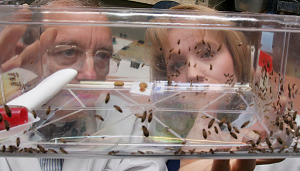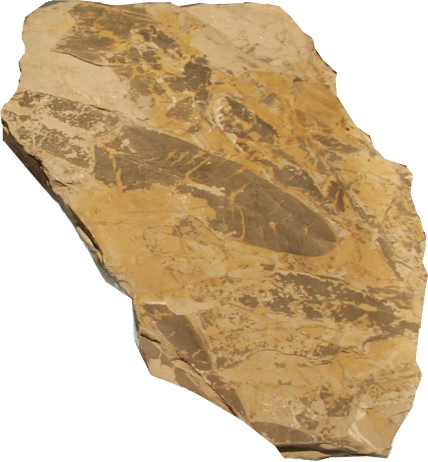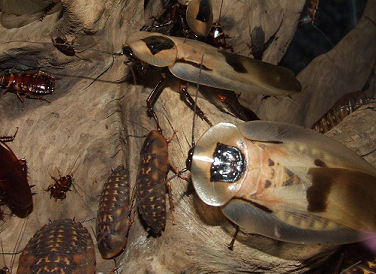![]() Cockroaches are primitive winged insects. They are relatively unchanged from fossils that date back 350 million years. Fossil records also show their close relationship with the more recently evolved termites.
Cockroaches are primitive winged insects. They are relatively unchanged from fossils that date back 350 million years. Fossil records also show their close relationship with the more recently evolved termites.

In fact, after comparisons of the DNA of cockroaches and termites, the order Isoptera (termites) has recently been absorbed into Blattodea (cockroaches) just as ants are in the order Hymenoptera along with wasps and bees. This may be of great excitement to taxonomists but has less impact on us than was caused by the splitting of a genus in mosquitoes where we have to try to remember a new species name. Many cockroach fossils are found in association with plants, especially ferns, suggesting they mainly inhabited moist, low environments. Some had already adapted to drier environments.
 Cockroaches are abhorred because they spread disease, their tainting odour of areas they infest, their fouling of all surfaces they contact including food and their fast reproduction rate with the ability to build to enormous numbers. They scare unsuspecting people at night and are difficult to squash because of their speed and unpredictable movements. They are also attributed to be a major cause of asthma. Of over 3,500 known species of cockroaches, less than ten are regarded as pests:
Cockroaches are abhorred because they spread disease, their tainting odour of areas they infest, their fouling of all surfaces they contact including food and their fast reproduction rate with the ability to build to enormous numbers. They scare unsuspecting people at night and are difficult to squash because of their speed and unpredictable movements. They are also attributed to be a major cause of asthma. Of over 3,500 known species of cockroaches, less than ten are regarded as pests:
German cockroach – Blattella germanica. Easily distinguished by its slender body with distinct dark parallel bands running through the length of the pronotum. Probably originated from
Oriental cockroach – Blatta orientalis. A medium size cockroach, dark reddish brown / black colour, most obvious feature is the greatly reduced wings on the female. Originally from north Africa, it now occurs mainly in temperate climates, often outside and at lower levels of buildings.
American cockroach – Periplaneta
Australian cockroach – Periplaneta australasiae. Similar to the American cockroach but has a brighter ring around the pronotum which continues along the base of the outer wing. It is more likely to fly, prefers a warmer environment and prefers gardens to drains.
Smoky-brown cockroach – Periplaneta fuliginosa A relatively large cockroach, dark brown to black without pale markings. A sub-tropical species it is similar in habits to the American cockroach. It inhabits sheds, roof voids and the like but rarely enters inside houses.
Brown-banded cockroach – Supella supellectilium Similar in size to the German cockroach. The edges of the pronotum are transparent, the remainder dark. The nymph has two distinct brown bands, one across the thorax, the other across the first few abdominal segments. Also of African origin. It spreads throughout infested premises often harbouring in furniture, bedding, cupboards etc. It’s widespread dispersal makes it difficult to control. It often flies when disturbed.

HABITS
The cockroaches that have developed to live amongst us have well developed survival skills. A thorough understanding a pest’s habits is necessary to optimize management measures to ensure maximum control is achieved.
Omnivorous feeding – cockroaches eat virtually any animal or plant material whether fresh or processed, from crumbs and grease to the vegetable gum used in book binding.
Nocturnal activity – occupants are often unaware of cockroach activity, especially in office tearooms where they come out after everyone has gone home.
Aggregation – cockroaches have an aggregation pheromone on their cuticle and in their droppings that indicates areas of safety.
Thigmotactic response – cockroaches choose harbourages where they are in contact with surfaces around them – that is why they hide in cracks and crevices.
Grooming – cockroaches clean their antennae and legs by running them through their mouth with a nibbling action.
EARLY CONTROL MEASURES
Dusts from minerals and plants were used from the mid 1800’s. Actives included borax, sodium fluoride, pyrethrum and diatomaceous earth.
Fumigation using hydrocyanic acid, carbon disulphide and sulphur dioxide. The latter was described as ‘the easiest and safest for the ordinary householder’, it was not recommended to do it on a damp day because it would ‘tarnish and corrode metal, bleach coloured fabrics and discolour wallpaper’.
Baiting Early attempts at baiting included mixing plaster of paris and flour in a saucer with another within easy access containing water. Cockroaches readily went to the flour, then became thirsty and drank the water – result – the plaster sets, clogging the intestines. In the early 1900s, phosphorous was mixed into a paste with sweetened flour and placed on cards for cockroaches to eat.
Trapping Many types of traps have been used – from jam jars (does not work for Germans because they can walk up glass) to scalding water over wetted old clothes.
Sealing holes Minimizing harbourages is useful but cockroaches will always find a new one – especially German roaches.
Biological control Hedgehogs and tree frogs have been used to control cockroaches.
 MODERN COCKROACH MANAGEMENT
MODERN COCKROACH MANAGEMENT
Inspection, Monitoring and Identification
- Inspection must be thorough; cockroaches aggregate and missing one harbourage may jeopardize the entire treatment. Ensure there is access to all areas.
- Cockroaches commonly aggregate around the dishwasher etc – hot, moist environments – but may be found in unusual places in complexes treated frequently if repellent insecticides have been used – eg above a suspended ceiling in the hallway of an entertainment venue.
- Use pyrethroids to flush cockroaches out of harbourages.
- Use sticky boards to check for cockroach activity, enhance effectiveness with food attractant..
- Ensure staff record any cockroach sightings in a pest (must be checked off at each service).
- Frequency of inspection / treatment is also very important.
- Examination of the evidence of activity can lead to a successful ID which may give an indication of the probable source(s) of the infestation.
Non-chemical strategies
- Sanitation – clean up of food and water, preferably immediately after each day’s work, including garbage (but populations cannot be controlled by this alone).
- Harbourage alteration - removal and denial by sealing.
- Exclusion – proofing of the premises and checking of incoming goods.
- Storage of food in sealed containers with good stock rotation.
- Regular (at least monthly) clean-up of grease, drains, food on shelves etc
- Trapping – good for monitoring, less effective for rapid breeding species and where there are many harbourages.
 Chemicals
Chemicals
The key to efficiency and efficacy is the selection of the appropriate insecticide, taking into account active ingredient and formulation, for each species and application site. Work best as part of an IPM strategy.
- German roaches are less sensitive to pyrethroids than other species.
- IGRs, especially CSIs, mixed with adulticides are very effective in longer term management.
- Dusts penetrate voids far more effectively than sprays.
- Baits use the aggregation habit of cockroaches to advantage. They have long residual life, provide targeted application, can be used in sensitive environments, can be applied without inconveniencing normal routine and the cockroach takes them into the source. Baits must be placed near harbourages so cockroaches can find them.
- Do not apply repellents (pyrethroids) near bait.
- In food premises consider using two baits to enhance acceptance against food competition.
